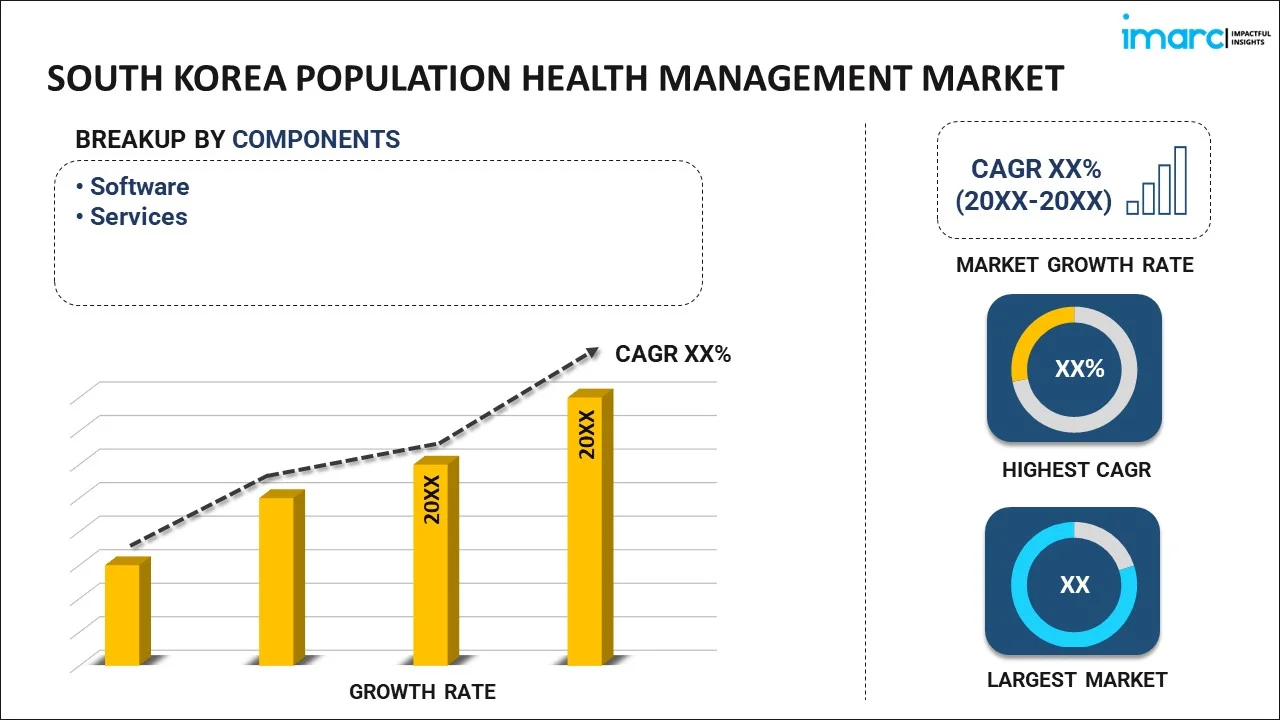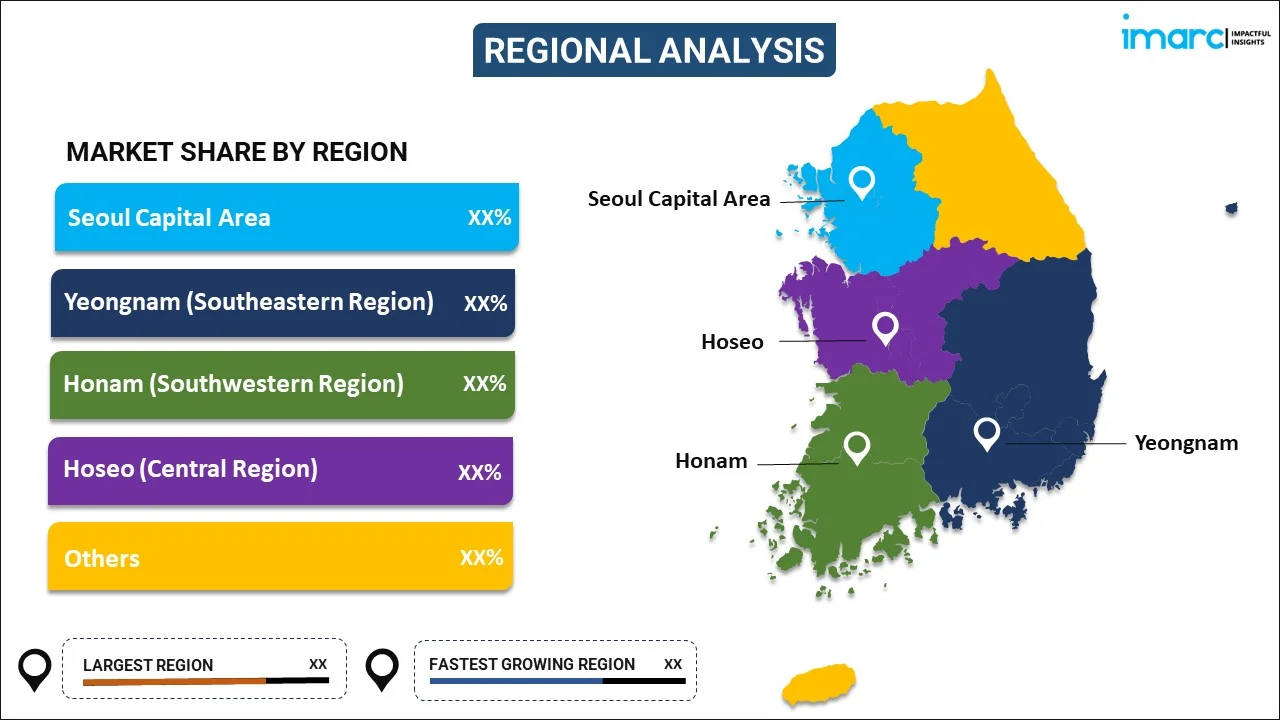
South Korea Population Health Management Market Report by Component (Software, Services), Mode of Delivery (Cloud-based, Web-based, On-premises), End User (Healthcare Providers, Healthcare Payers, Employer Groups, Government Bodies), and Region 2024-2032
Market Overview:
South Korea population health management market size is projected to exhibit a growth rate (CAGR) of 17.20% during 2024-2032. The escalating demand for comprehensive and integrated healthcare solutions, coupled with the rising preference for personalized medicines, is primarily driving the market growth across the country.
|
Report Attribute
|
Key Statistics
|
|---|---|
|
Base Year
|
2023 |
|
Forecast Years
|
2024-2032
|
|
Historical Years
|
2018-2023
|
| Market Growth Rate (2024-2032) | 17.20% |
Population health management (PHM) represents a comprehensive approach to enhancing clinical health outcomes through improved coordination of care and increased patient engagement. This encompasses a range of thorough and authoritative strategies, including compliance programs, health economics, outcome assessments, healthcare reforms, care coordination, and resource management. PHM serves healthcare providers by identifying and addressing care gaps, advocating wellness through evidence-based decision support, and elevating the overall patient experience. Additionally, it contributes to heightened clinical efficiency, fostering patient-centric care by reducing readmission rates, ensuring appropriate and optimal interventions, and providing real-time monitoring and access to medical information. PHM serves as a patient-centric platform, striving to enhance the health of the population by facilitating informed health decisions and supporting overall wellness.
South Korea Population Health Management Market Trends:
The South Korea population health management market is experiencing significant growth, reflecting the nation's commitment to advancing healthcare outcomes through a holistic and patient-centric approach. One key aspect of the market is its role in aiding healthcare providers to identify and address care gaps, thereby promoting overall wellness through evidence-based decision support. Besides this, by leveraging sophisticated tools and technologies, PHM facilitates a proactive approach to healthcare, focusing on preventive measures and early intervention to improve health outcomes. Moreover, the integration of population health management in South Korea is instrumental in enhancing clinical efficiency, which is acting as another significant growth-inducing factor. This is achieved by reducing hospital readmission rates, ensuring the appropriateness and optimization of interventions, and providing real-time monitoring and access to medical information. In addition to improving individual health outcomes, the South Korea population health management market plays a pivotal role in addressing broader public challenges. The country is also witnessing the incorporation of advanced technologies, such as data analytics and artificial intelligence, to enhance decision-making processes and drive continuous improvement in healthcare delivery. This, in turn, is expected to fuel the regional market over the forecasted period.
South Korea Population Health Management Market Segmentation:
IMARC Group provides an analysis of the key trends in each segment of the market, along with forecasts at the country level for 2024-2032. Our report has categorized the market based on component, mode of delivery, and end user.
Component Insights:

- Software
- Services
The report has provided a detailed breakup and analysis of the market based on the component. This includes software and services.
Mode of Delivery Insights:
- Cloud-based
- Web-based
- On-premises
A detailed breakup and analysis of the market based on the mode of delivery have also been provided in the report. This includes cloud-based, web-based, and on-premises.
End User Insights:
- Healthcare Providers
- Healthcare Payers
- Employer Groups
- Government Bodies
The report has provided a detailed breakup and analysis of the market based on the end user. This includes healthcare providers, healthcare payers, employer groups, and government bodies.
Regional Insights:

- Seoul Capital Area
- Yeongam (Southeastern Region)
- Honam (Southwestern Region)
- Hoseo (Central Region)
- Others
The report has also provided a comprehensive analysis of all the major regional markets, which include Seoul Capital Area, Yeongam (Southeastern Region), Honam (Southwestern Region), Hoseo (Central Region), and Others.
Competitive Landscape:
The market research report has also provided a comprehensive analysis of the competitive landscape in the market. Competitive analysis such as market structure, key player positioning, top winning strategies, competitive dashboard, and company evaluation quadrant has been covered in the report. Also, detailed profiles of all major companies have been provided.
South Korea Population Health Management Market Report Coverage:
| Report Features | Details |
|---|---|
| Base Year of the Analysis | 2023 |
| Historical Period | 2018-2023 |
| Forecast Period | 2024-2032 |
| Units | US$ Million |
| Scope of the Report | Exploration of Historical and Forecast Trends, Industry Catalysts and Challenges, Segment-Wise Historical and Predictive Market Assessment:
|
| Components Covered | Software, Services |
| Mode of Deliveries Covered | Cloud-based, Web-based, On-premises |
| End Users Covered | Healthcare Providers, Healthcare Payers, Employer Groups, Government Bodies |
| Regions Covered | Seoul Capital Area, Yeongnam (Southeastern Region), Honam (Southwestern Region), Hoseo (Central Region), Others |
| Customization Scope | 10% Free Customization |
| Report Price and Purchase Option | Single User License: US$ 3699 Five User License: US$ 4699 Corporate License: US$ 5699 |
| Post-Sale Analyst Support | 10-12 Weeks |
| Delivery Format | PDF and Excel through Email (We can also provide the editable version of the report in PPT/Word format on special request) |
Key Questions Answered in This Report:
- How has the South Korea population health management market performed so far and how will it perform in the coming years?
- What has been the impact of COVID-19 on the South Korea population health management market?
- What is the breakup of the South Korea population health management market on the basis of component?
- What is the breakup of the South Korea population health management market on the basis of mode of delivery?
- What is the breakup of the South Korea population health management market on the basis of end user?
- What are the various stages in the value chain of the South Korea population health management market?
- What are the key driving factors and challenges in the South Korea population health management?
- What is the structure of the South Korea population health management market and who are the key players?
- What is the degree of competition in the South Korea population health management market?
Key Benefits for Stakeholders:
- IMARC’s industry report offers a comprehensive quantitative analysis of various market segments, historical and current market trends, market forecasts, and dynamics of the South Korea population health management market from 2018-2032.
- The research report provides the latest information on the market drivers, challenges, and opportunities in the South Korea population health management market.
- Porter's five forces analysis assist stakeholders in assessing the impact of new entrants, competitive rivalry, supplier power, buyer power, and the threat of substitution. It helps stakeholders to analyze the level of competition within the South Korea population health management industry and its attractiveness.
- A competitive landscape allows stakeholders to understand their competitive environment and provides an insight into the current positions of key players in the market.
Need more help?
- Speak to our experienced analysts for insights on the current market scenarios.
- Include additional segments and countries to customize the report as per your requirement.
- Gain an unparalleled competitive advantage in your domain by understanding how to utilize the report and positively impacting your operations and revenue.
- For further assistance, please connect with our analysts.
 Inquire Before Buying
Inquire Before Buying
 Speak to an Analyst
Speak to an Analyst
 Request Brochure
Request Brochure
 Request Customization
Request Customization




.webp)




.webp)












